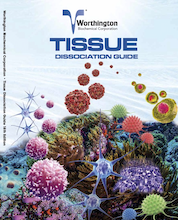For our international customers, please be advised that orders cannot be placed through our website by customers in countries with International Distributor representation.
Worthington Tissue Dissociation Guide
Dissociating Enzymes: Collagenase
Bacterial collagenase is a crude complex containing a collagenase more accurately referred to as clostridiopeptidase A which is a protease with a specificity for the X-Gly bond in the sequence Pro-X-Gly-Pro, where X is most frequently a neutral amino acid. Such sequences are often found in collagen, but only rarely in other proteins. While many proteases can hydrolyze single-stranded, denatured collagen polypeptides, clostridiopeptidase A is unique among proteases in its ability to attack and degrade the triple-helical native collagen fibrils commonly found in connective tissue.
True collagenase may cleave simultaneously across all three chains or attack at a single strand. Mammalian collagenases split collagen in its native triple-helical conformation at a specific site yielding fragments, TC A and TC B, representing 3/4 and 1/4 lengths of the tropocollagen molecule. After fragmentation the pieces tend to uncoil into random polypeptides and are more susceptable to attack by other proteases.
Bacterial collagenases are usually extracted from host invasive strains. These enzymes differ from mammalian collagenases in that they attack many sites along the helix. Collagenases from Clostridium histolyticum, first prepared by Mandl, et al., have been most thoroughly studied. Commercially available collagenase has been limited primarily to that from Cl. histolyticum although other sources have recently become available. Clostridial collagenase also degrades the helical regions in native collagen preferentially at the X-Gly bond in the sequence Pro-X-Gly-Pro where X is most frequently a neutral amino acid. This bond in synthetic peptide substrates may also be split.
Purified clostridiopeptidase A alone is usually inefficient in dissociating tissues due to incomplete hydrolysis of all collagenous polypeptides and its limited activity against the high concentrations of non-collagen proteins and other macromolecules found in the extracellular matrix. The collagenase most commonly used for tissue dissociation is a crude preparation containing clostridiopeptidase A in addition to a number of other proteases, polysaccharidases and lipases. Crude collagenase is well suited for tissue dissociation since it contains the enzyme required to attack native collagen and reticular fibers in addition to the enzymes which hydrolyze the other proteins, polysaccharides and lipids in the extracelluar matrix of connective and epithelial tissues.
The first commercially available collagenase was offered by Worthington in 1959. At that time we offered one type of crude enzyme which we tested only for collagenase activity. Eventually, with the cooperation of many in the research community, four basic profiles were identified:
Type 1 containing average amounts of assayed activities (collagenase, caseinase, clostripain, and tryptic activities). It is generally recommended for epithelial, liver, lung, fat, and adrenal tissue cell preparations.
Type 2 containing greater clostripain activity. It is generally used for heart, bone, muscle, thyroid and cartilage.
Type 3 selected because of low proteolytic activity. It is usually used for mammary cells.
Type 4 selected because of low tryptic activity.. It is commonly used for islets and other applications where receptor integrity is crucial.
Introduced in 2007, Animal Origin Free collagenase (code CLSAFA) is derived from cultures grown in medium completely devoid of animal based components and designed for bioprocessing applications where introduction of potential animal derived pathogens must be prevented. Levels of secondary proteases are similar to Types 1 and 2.
Correlations between type and effectiveness with different tissues have been good, but not perfect, due in part to variable parameters of use. Nevertheless most researchers consider the tissue-typing of crude collagenase lots to be a valuable service. A detailed description of the Worthington collagenase assay as well as our procedure for Clostridiopeptidase A testing can be found in the Worthington Enzyme Manual.
If you find one of the types of collagenases suitable for your cell isolation procedure, you may want to try Worthington’s Collagenase Sampling Program. This cost-free program lets researchers pre-sample different lots of collagenase and evaluate them in their specific applications to achieve the best combination of cell yield and viability.
Tissue Tables
The Worthington Tissue Tables provide references useful to researchers interested in tissue dissociation and cell harvesting procedures. The references are organized by Tissue and Species type and linked to PubMed citations. The Cell type, Enzymes, and Medium for each reference is provided.
To search by specific criteria, use the Tissue References Search Tool.
